A quick note from the editor: my apologies for the extended gap between posts. I hope to return to more frequent updates to this site, although I cannot make any commitments. If you’ve sent me an email in the past few months I plan to reply soon.
Construction is underway on Slabtown Savier, a two-building development in NW Portland’s emerging Slabtown neighborhood. The development, designed by SERA Architects for developer Greystar, will include two buildings with 363 market rate apartments. Vehicular parking will be provided via a combination of tuck-under and below grade parking. 399 long term bicycle parking spaces will be provided, split between in-unit spaces and spaces in secured bike rooms.
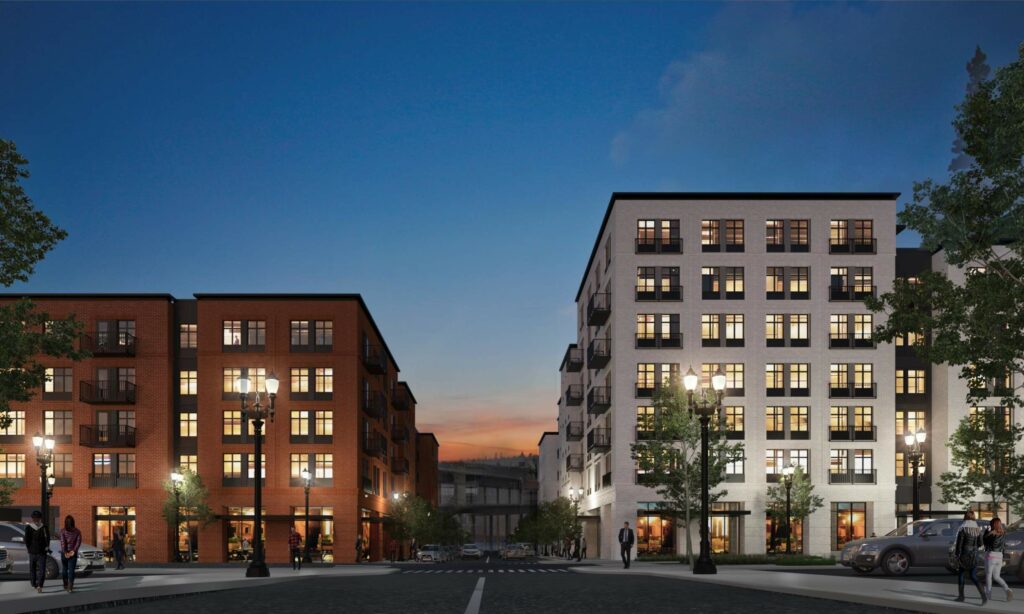
The development will be located on the western portion of Blocks 261 of 262 of the Con-way Master Plan, bound by NW 20th Ave, NW Thurman St, NW 19th Ave and NW Raleigh St. The site was most recently used as surface parking.
The Con-way Master Plan wass approved in 2012. Changes made to the zoning code since 2012 do not apply to projects developed in the Con-way Master Plan area. As such the development does not need to comply with the city’s Inclusionary Housing ordinance, which came into effect in 2017.
Other buildings in the masterplan that have been completed in the Con-way Masterplan area include the LL Hawkins and Slabtown Marketplace, The Carson, Saltwood and the Leland James. Both the Block 290 and Slabtown Square and Conway Block 291E developments are currently under construction.
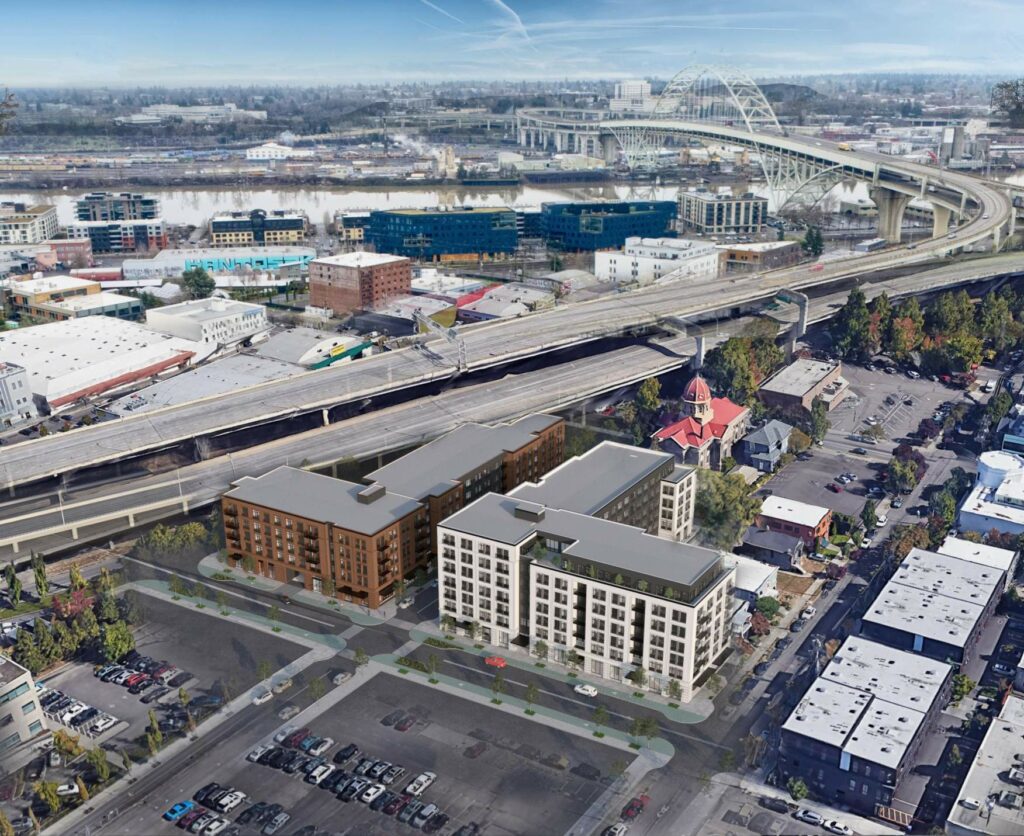
Both buildings at Slabtown Savier will be arranged in a L-shaped plan. The 5-story Block 261 to the north will include 149 residential units, while the 7-story Block 262 to the south will include 214 units. The massing of Block 262 steps down at its east side, in order to respond to the historic St. Patrick Catholic Church.
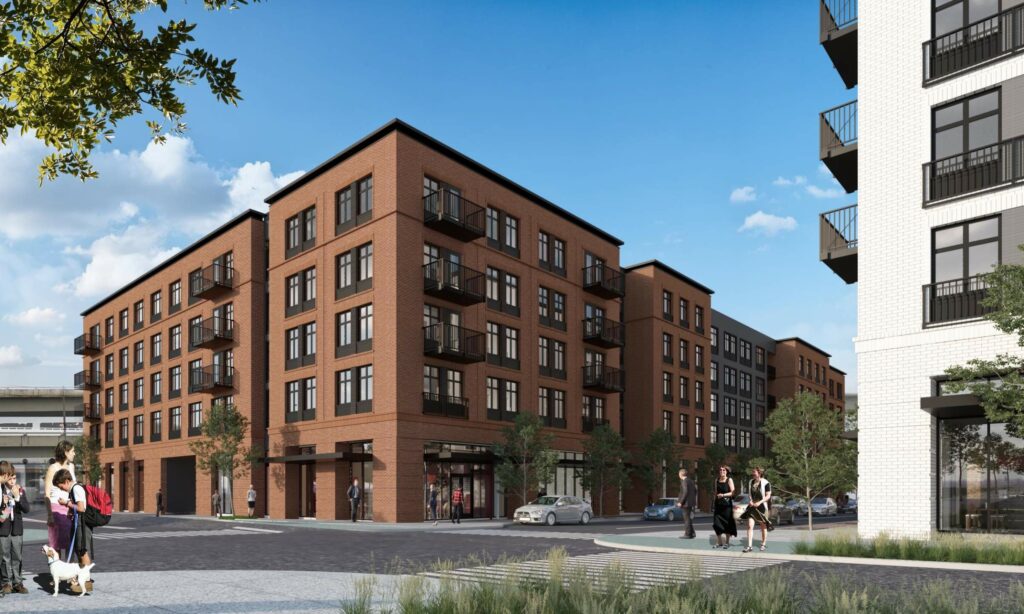
The primary material for the north building will be a red brick, with the south building using a combination of ivory and tan brick. Other materials proposed across the development include fiber cement panels, vinyl windows, aluminum storefront, metal canopies and metal balconies.
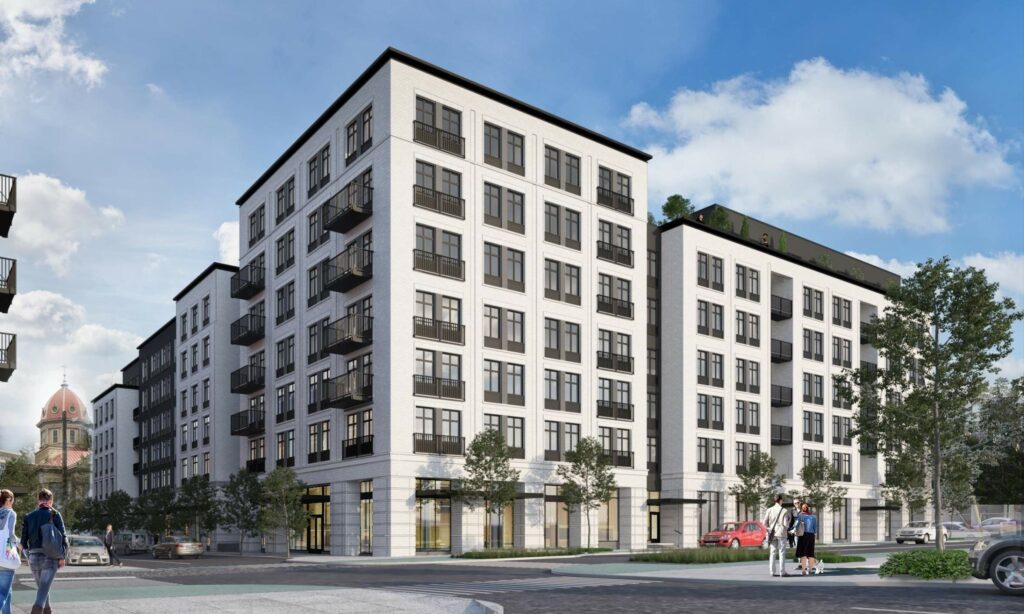
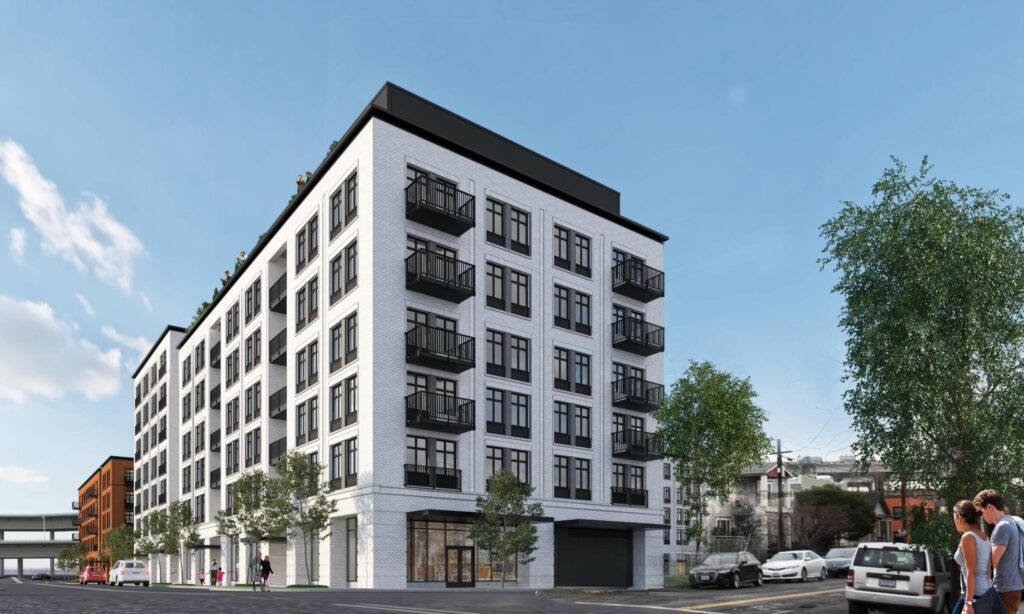
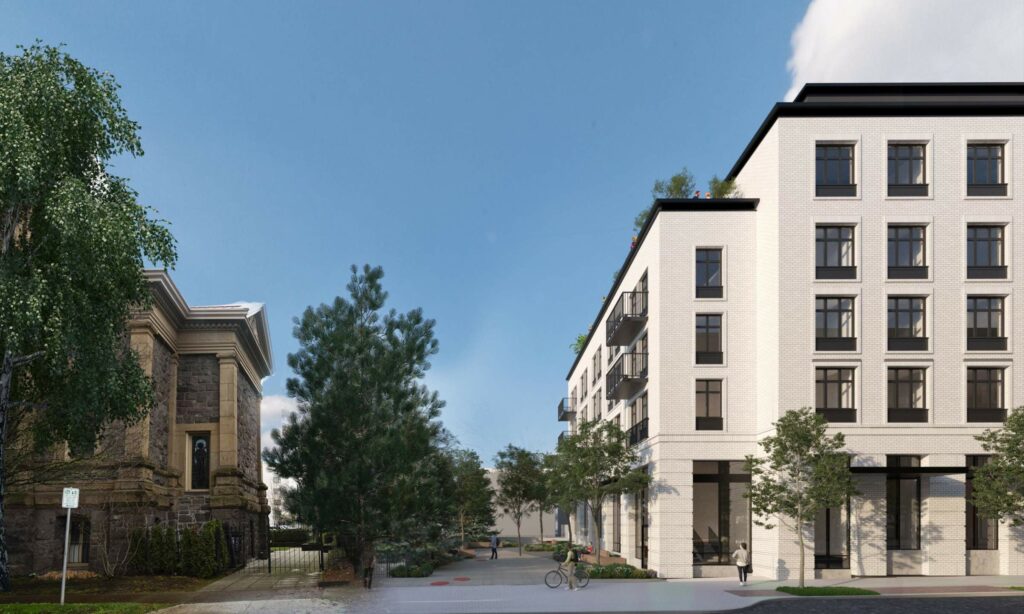
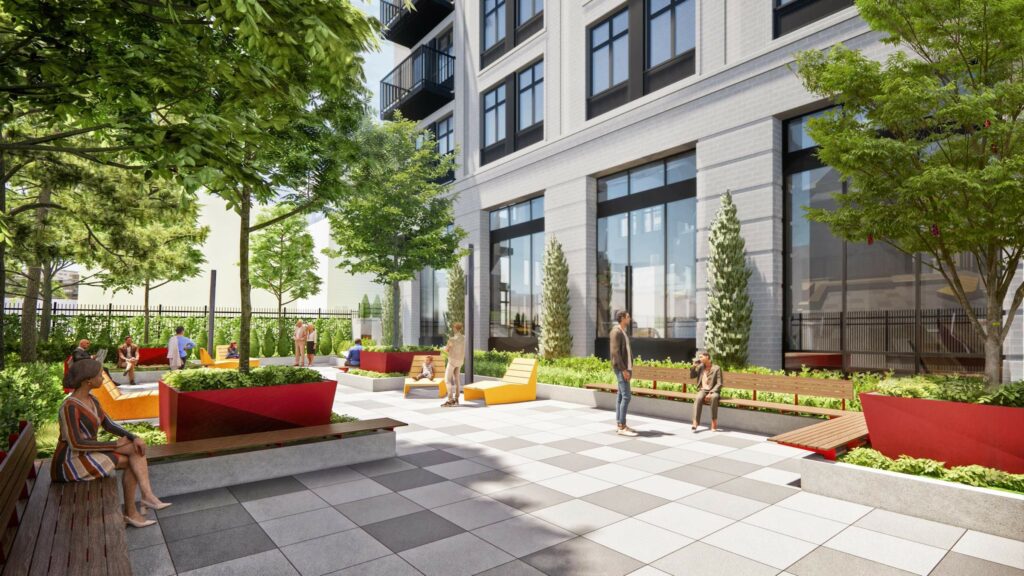
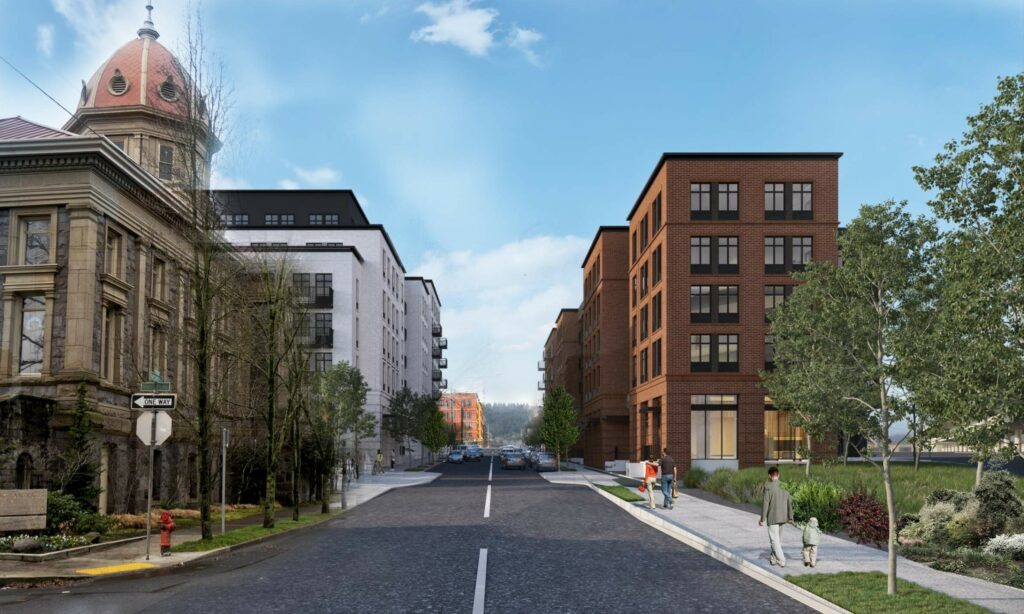
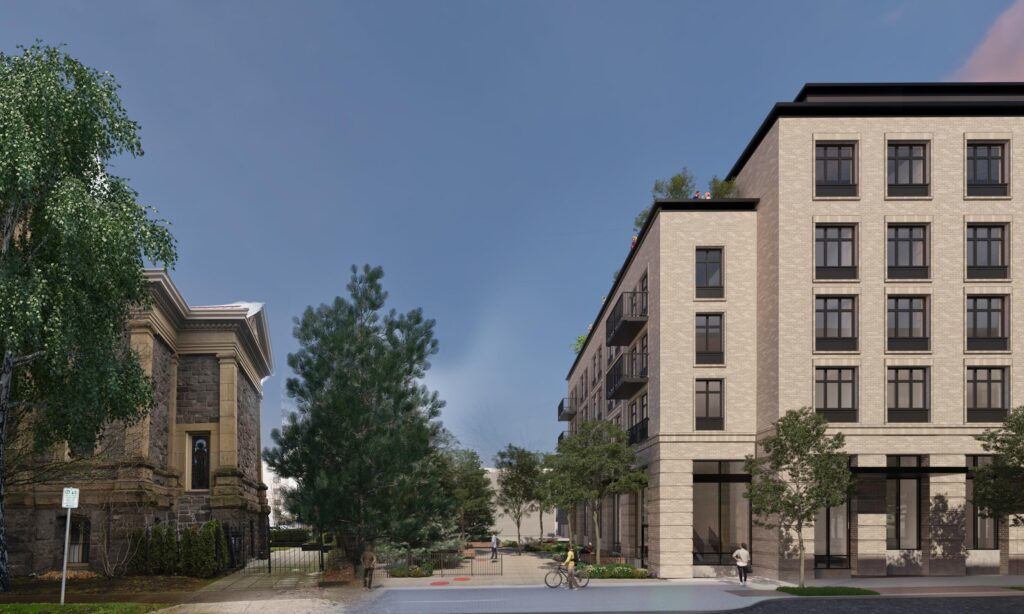
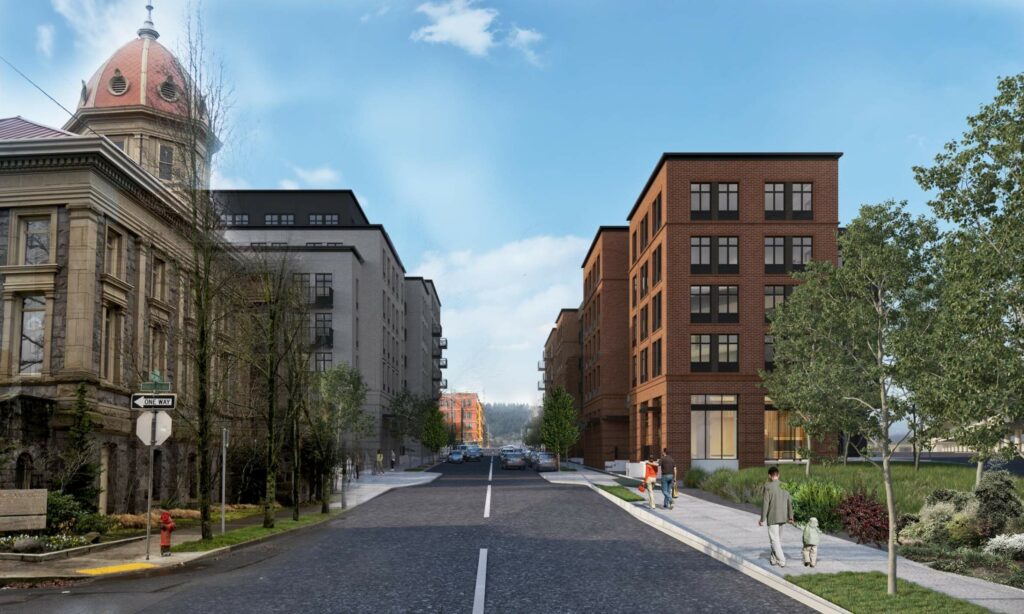
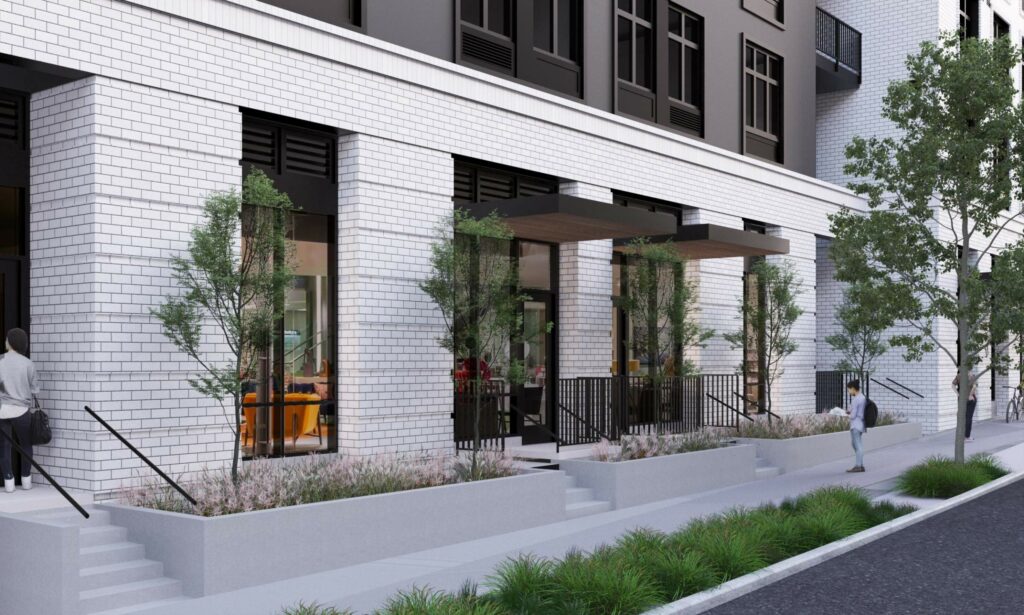
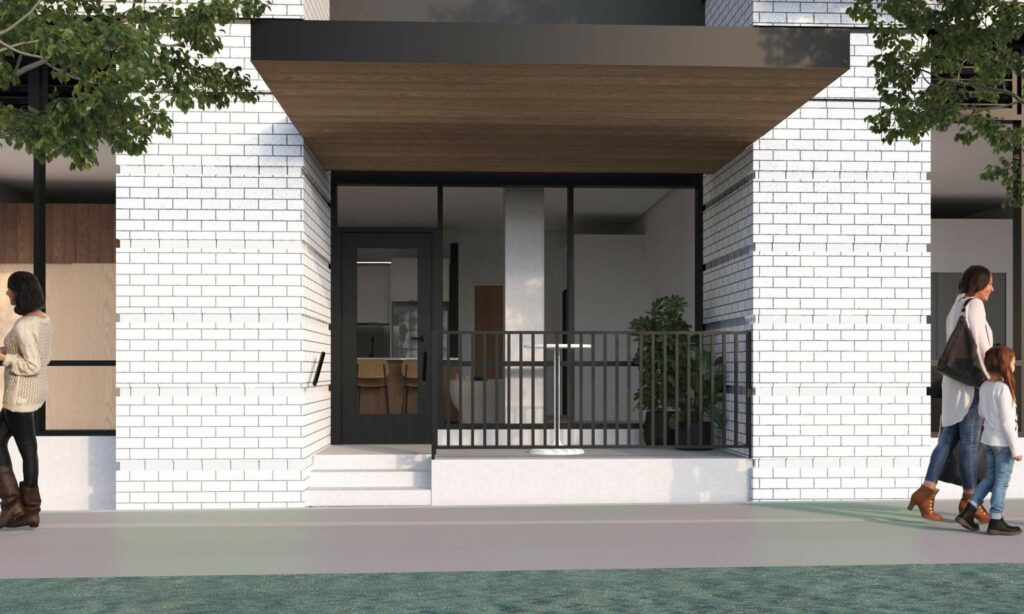
Slabtown Savier was approved on December 16th 2021, at its first Design Review hearing. The project had previously been presented to the Design Commission during two optional Design Advice Request meeting. In the conclusion to the Final Findings and Decision by the Design Commission it was found that the project will be “well integrated with the neighborhood”:
The proposed development on Blocks 261 and 262 will be well integrated with the neighborhood with materials and design features that reflect the character of the area including adhering to the partial block scale of development called for in the design guidelines, utilizing brick as a primary building cladding as do many other Con-way buildings, incorporating design details, adding unique open spaces to the eastern end of the two blocks, and significantly stepping down height and eroding massing towards the adjacent landmark. A large number of balconies, porches, patios, and upper-level terraces will activate the public realm and will provide human scale, allow interaction between residents and passers-by, and allow for informal surveillance of the street. The ground floor exterior is defined by extensive glazing, aluminum storefronts, accent wood cladding, steel canopies, exterior lighting, and fine masonry detailing.
A building permit for Slabtown Savier North was issued on November 23rd, 2022. The permit for Slabtown Savier South was issued on December 21st, 2022.
Drawings
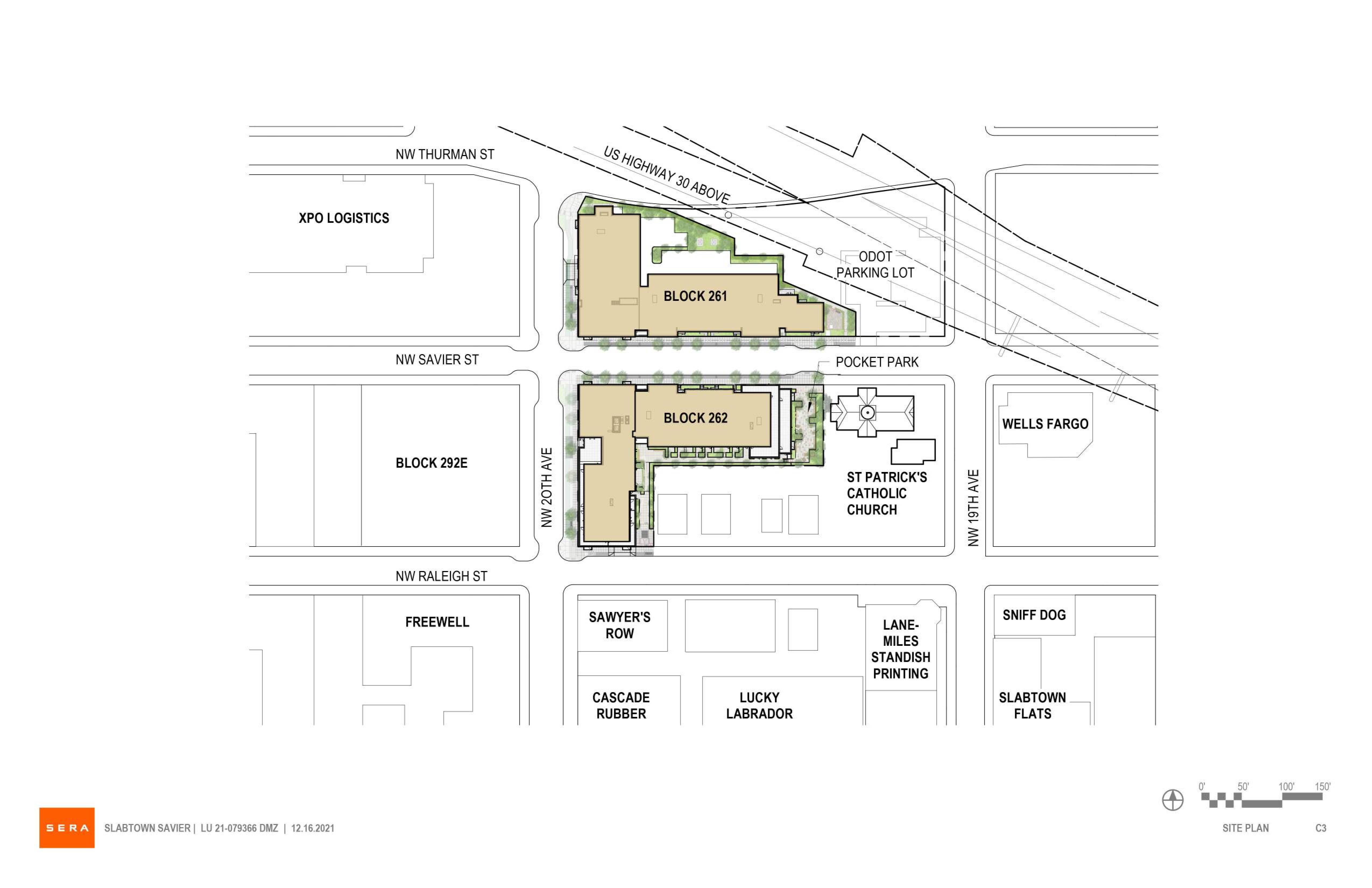
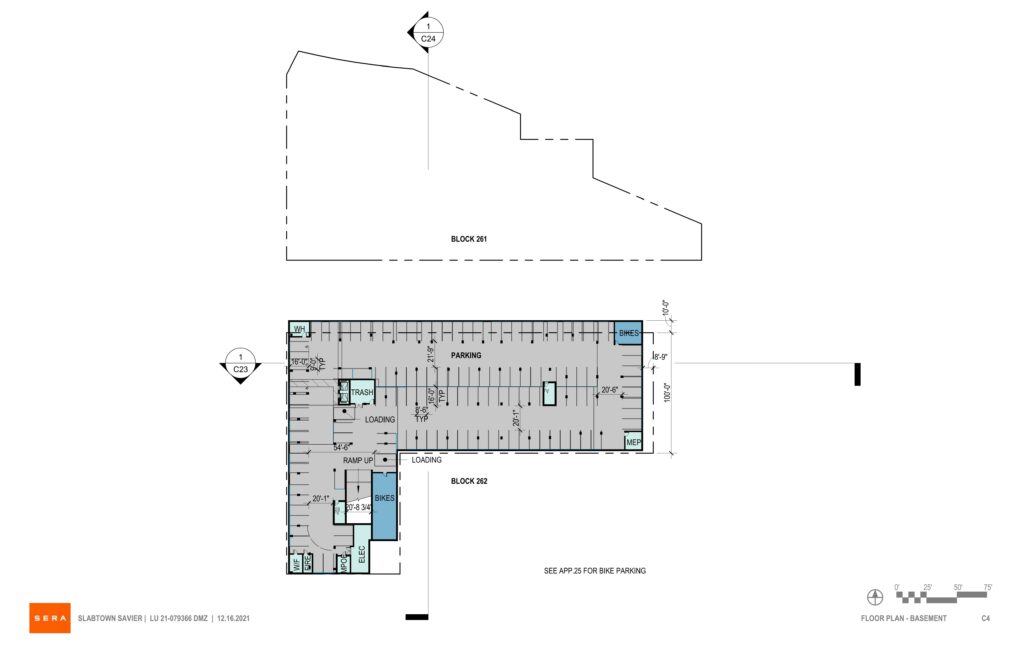
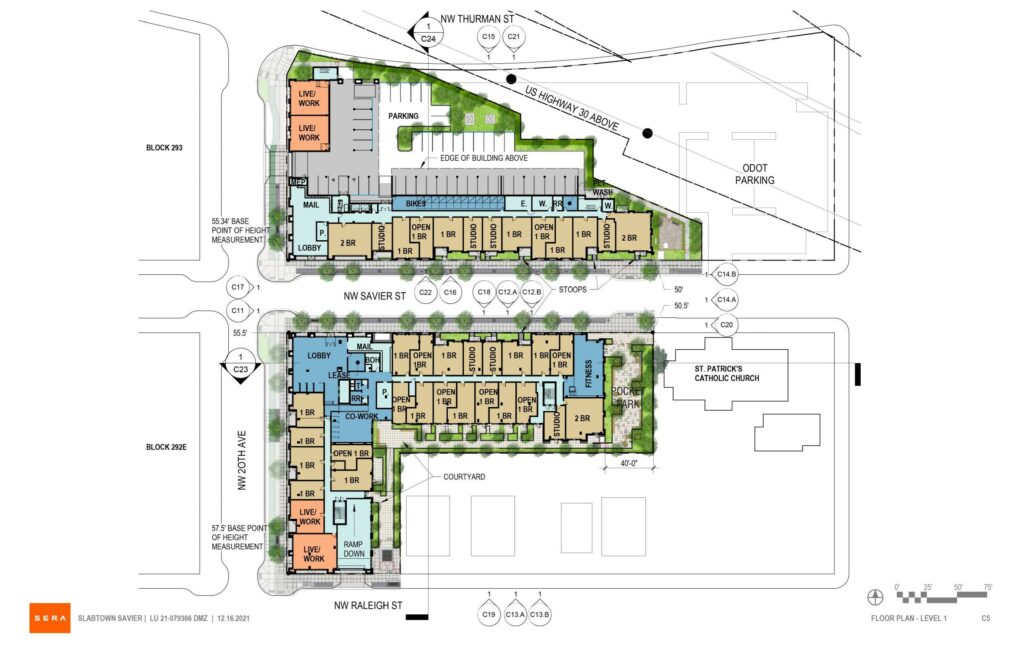
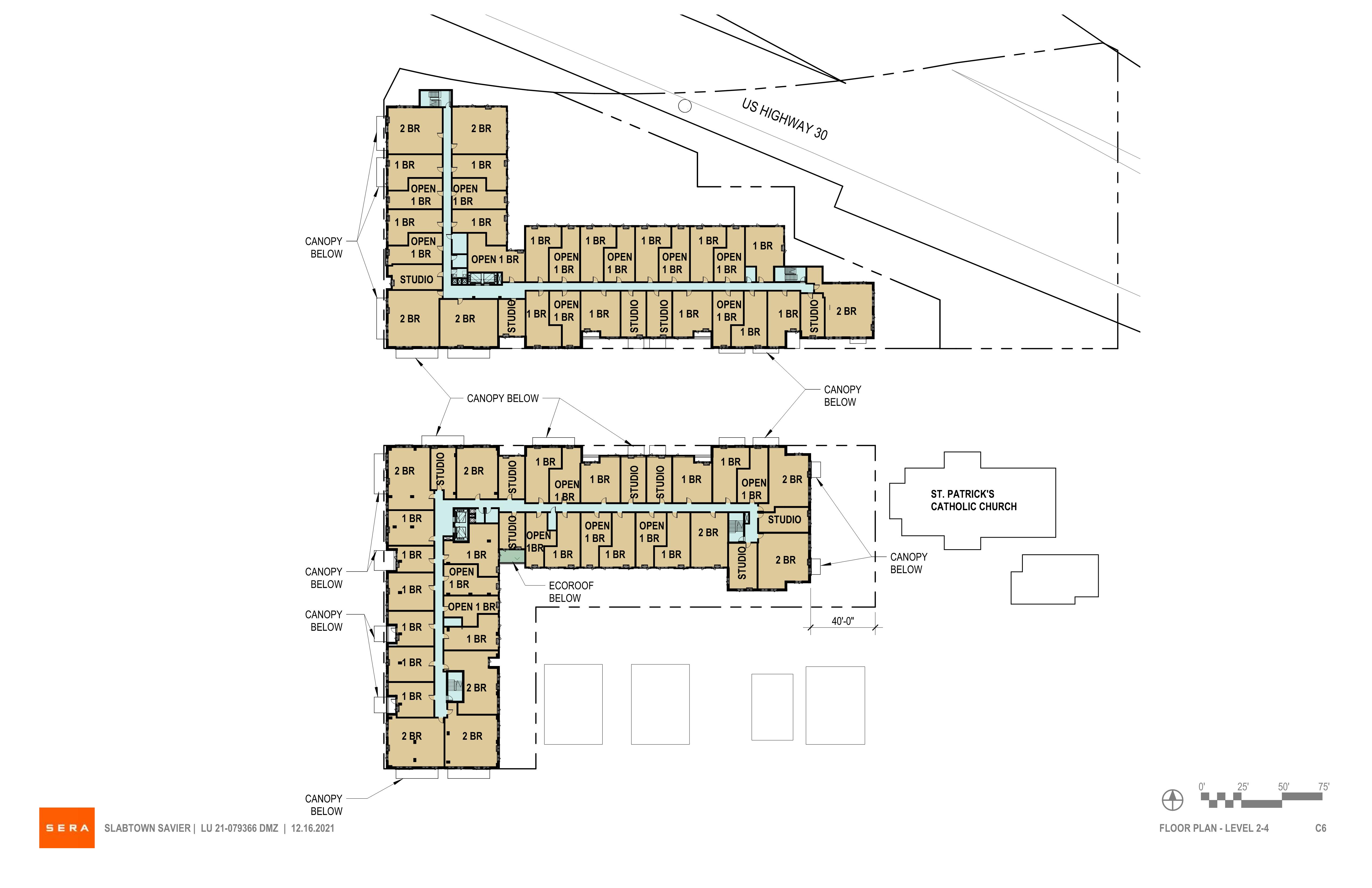
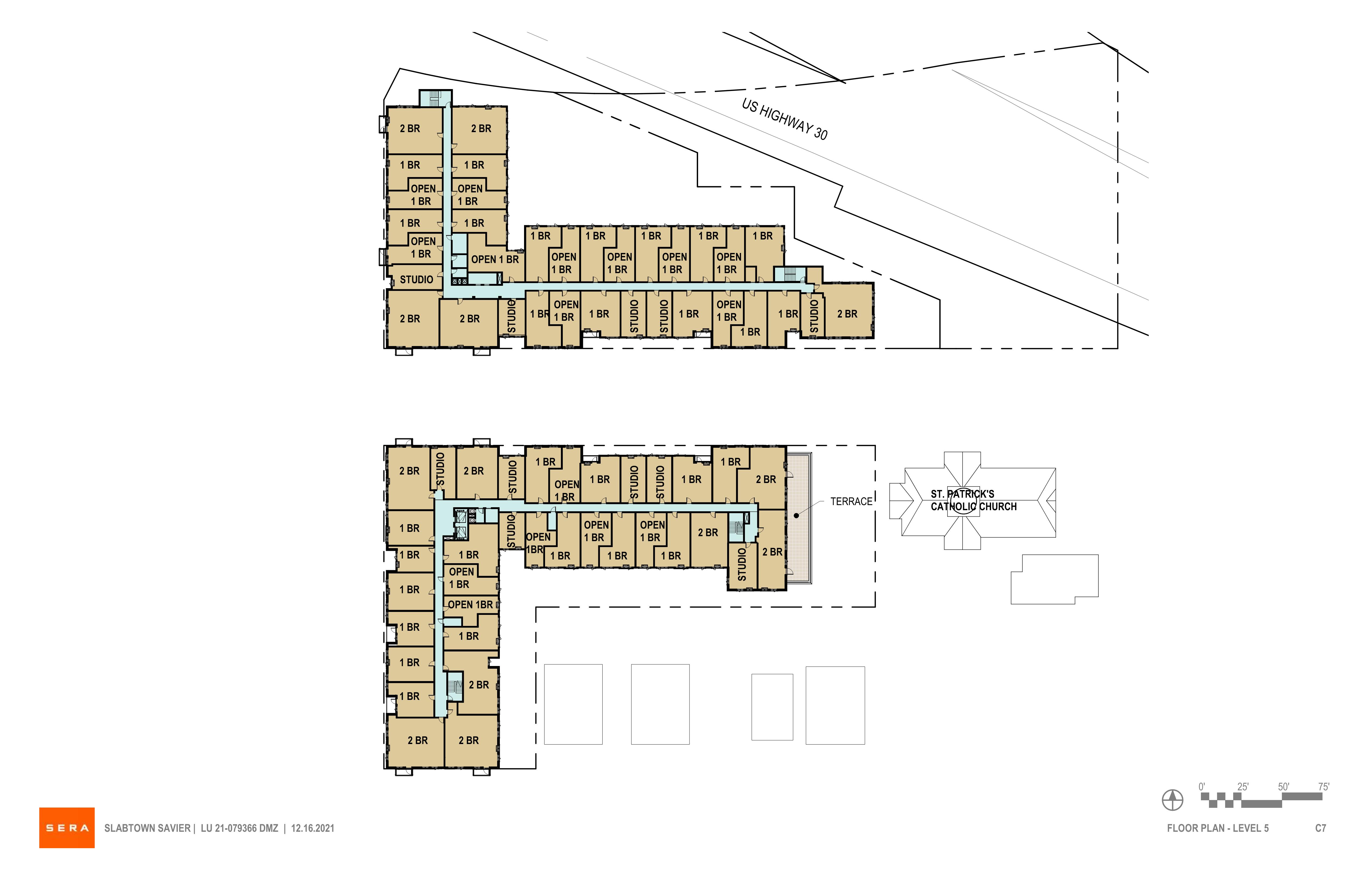
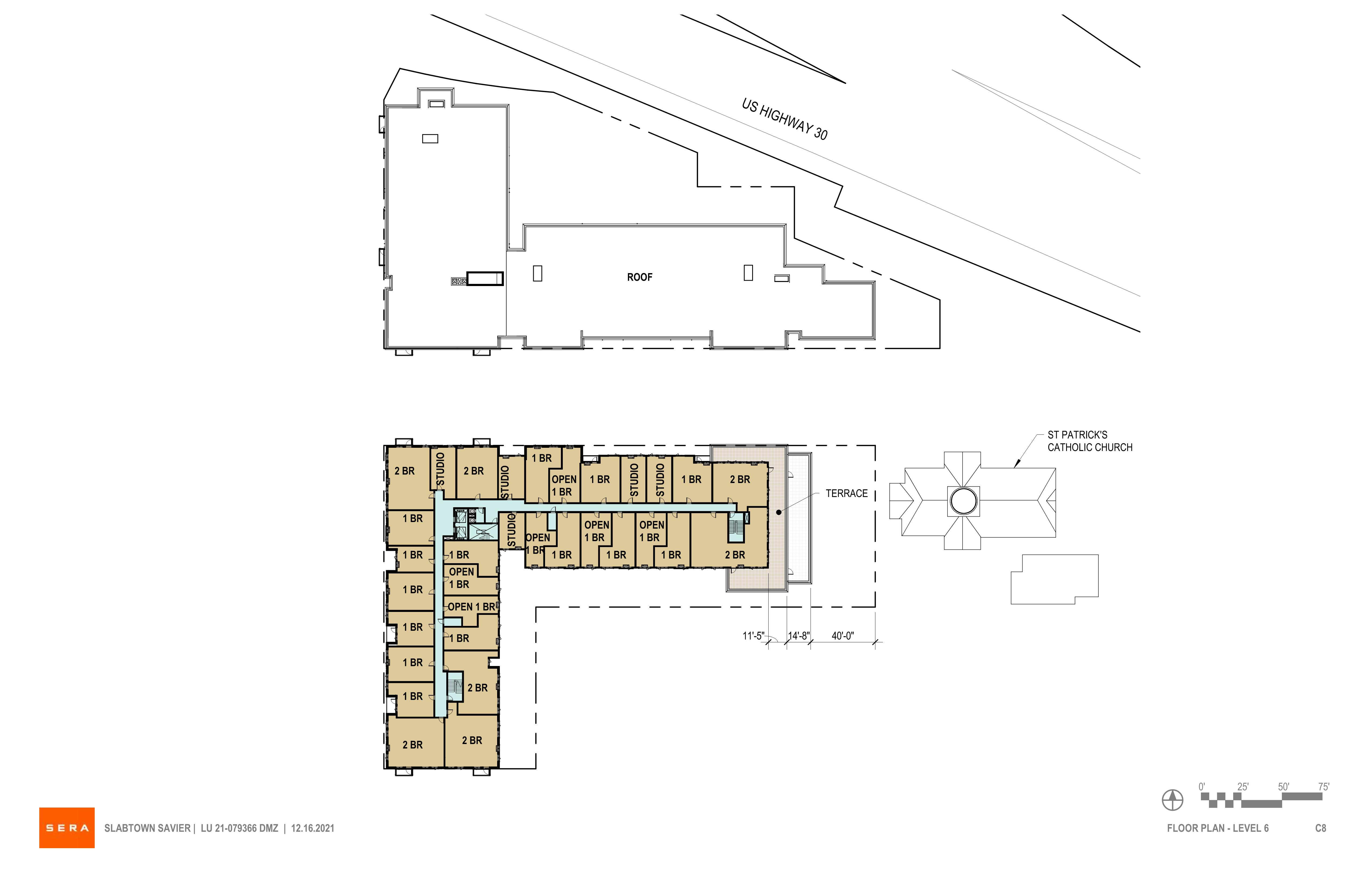
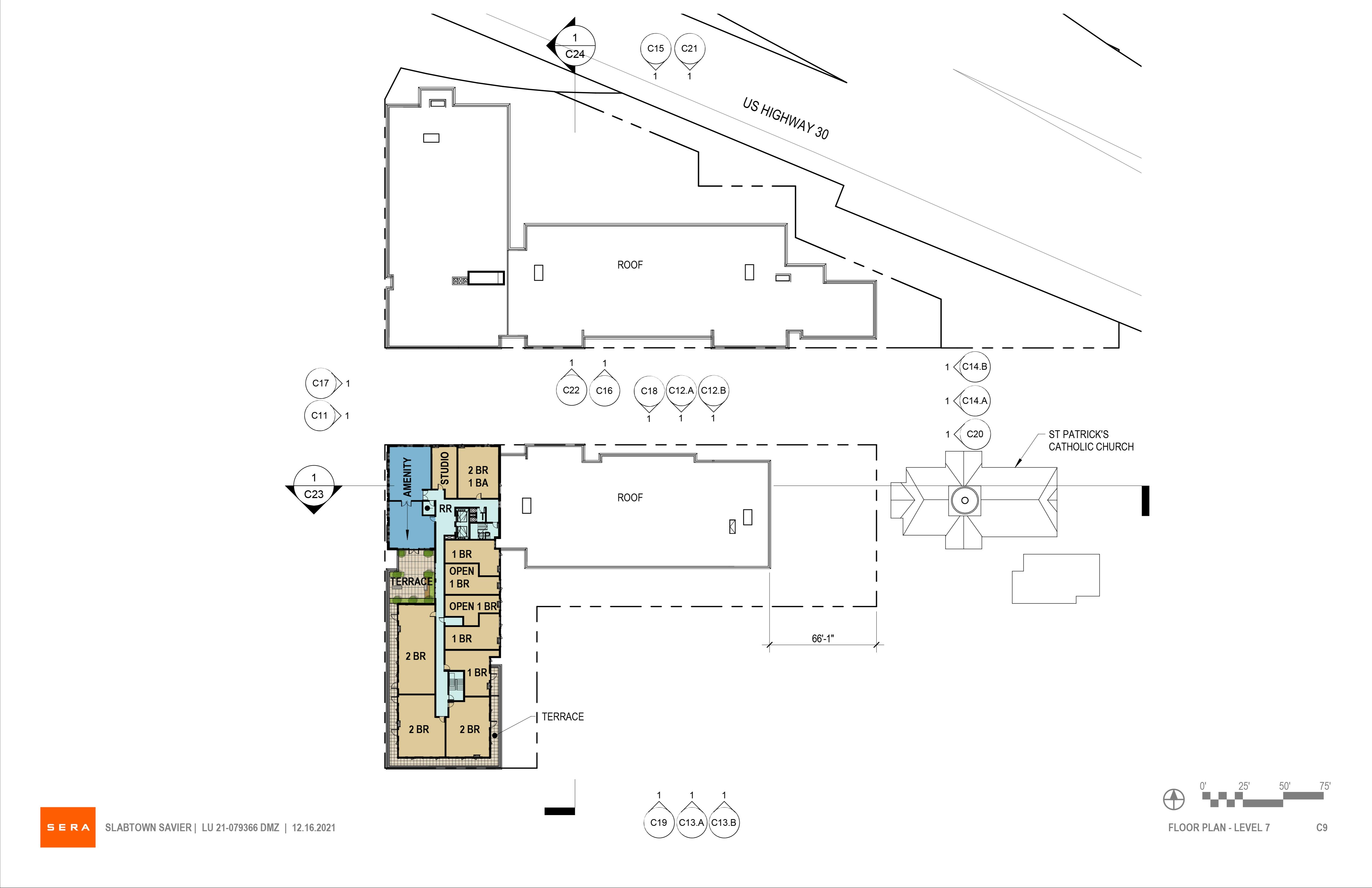
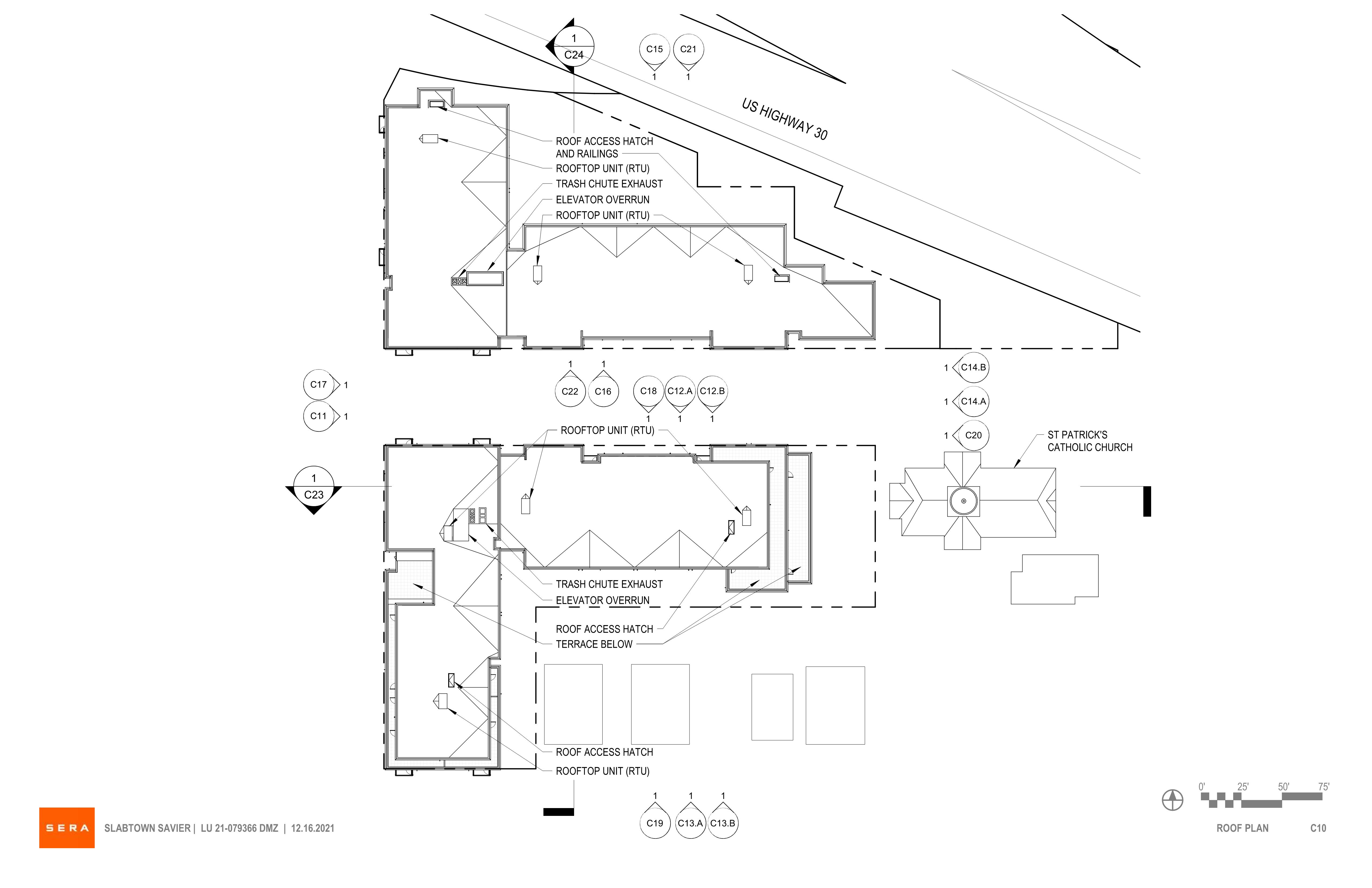
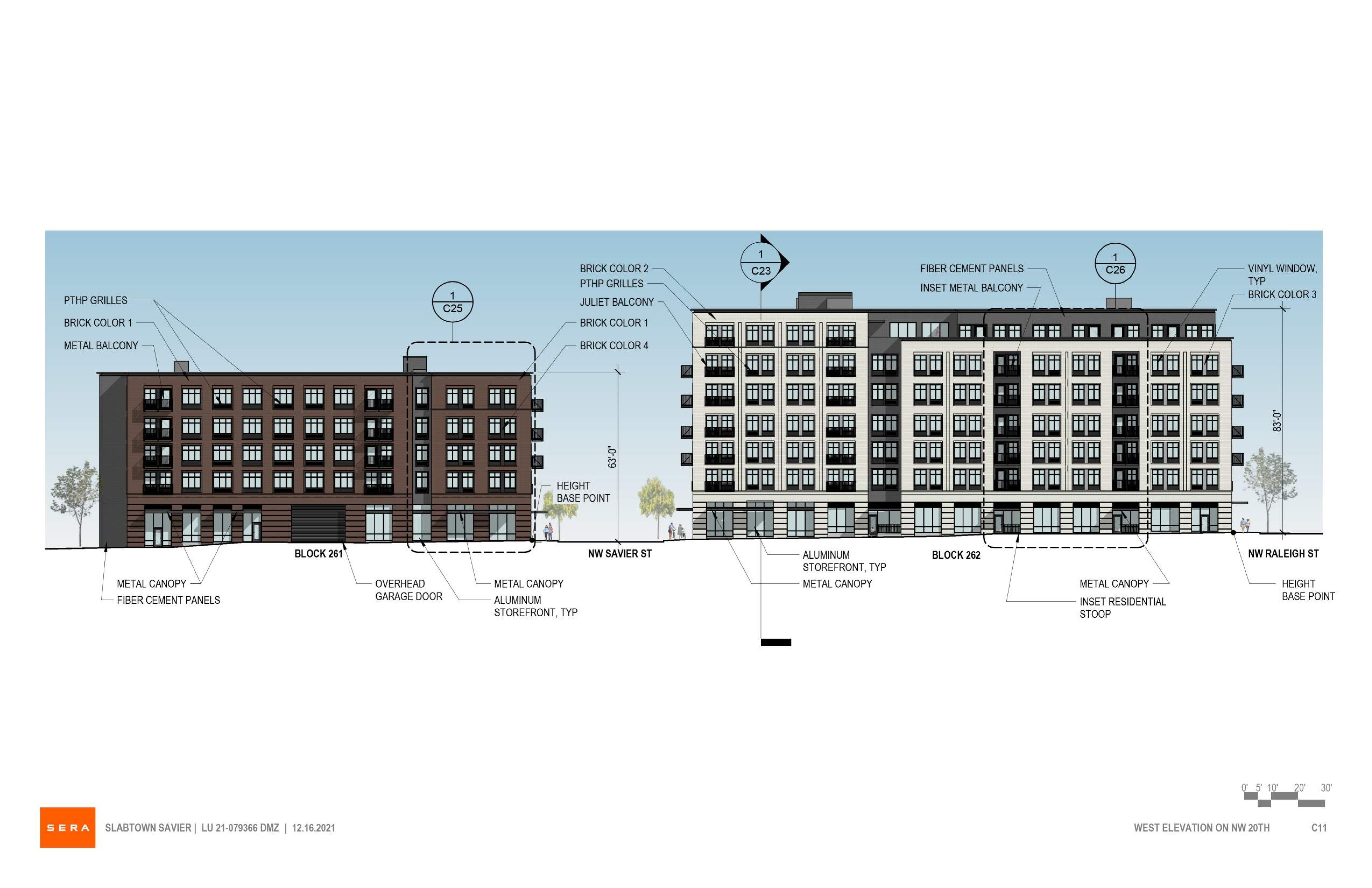
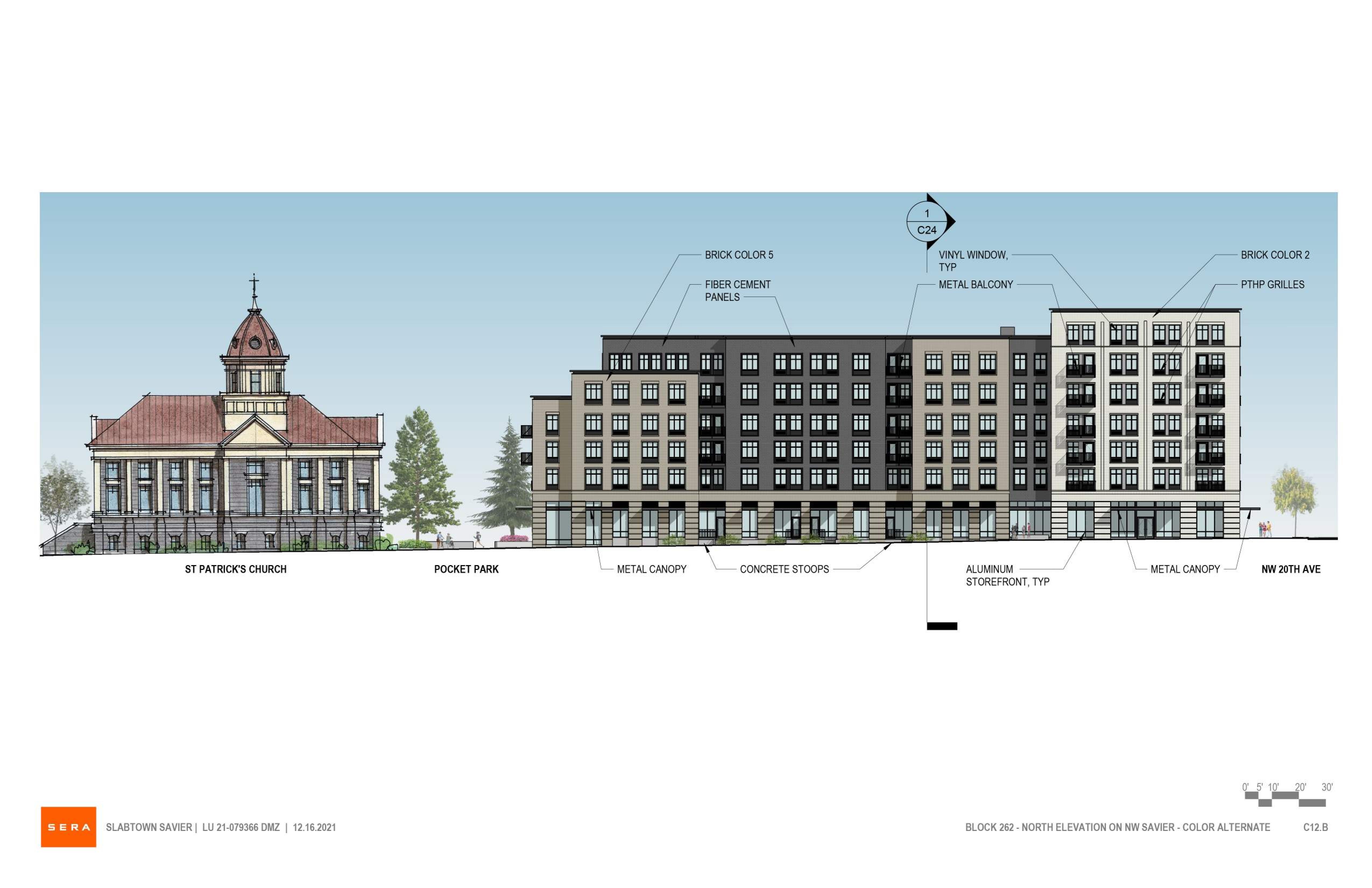
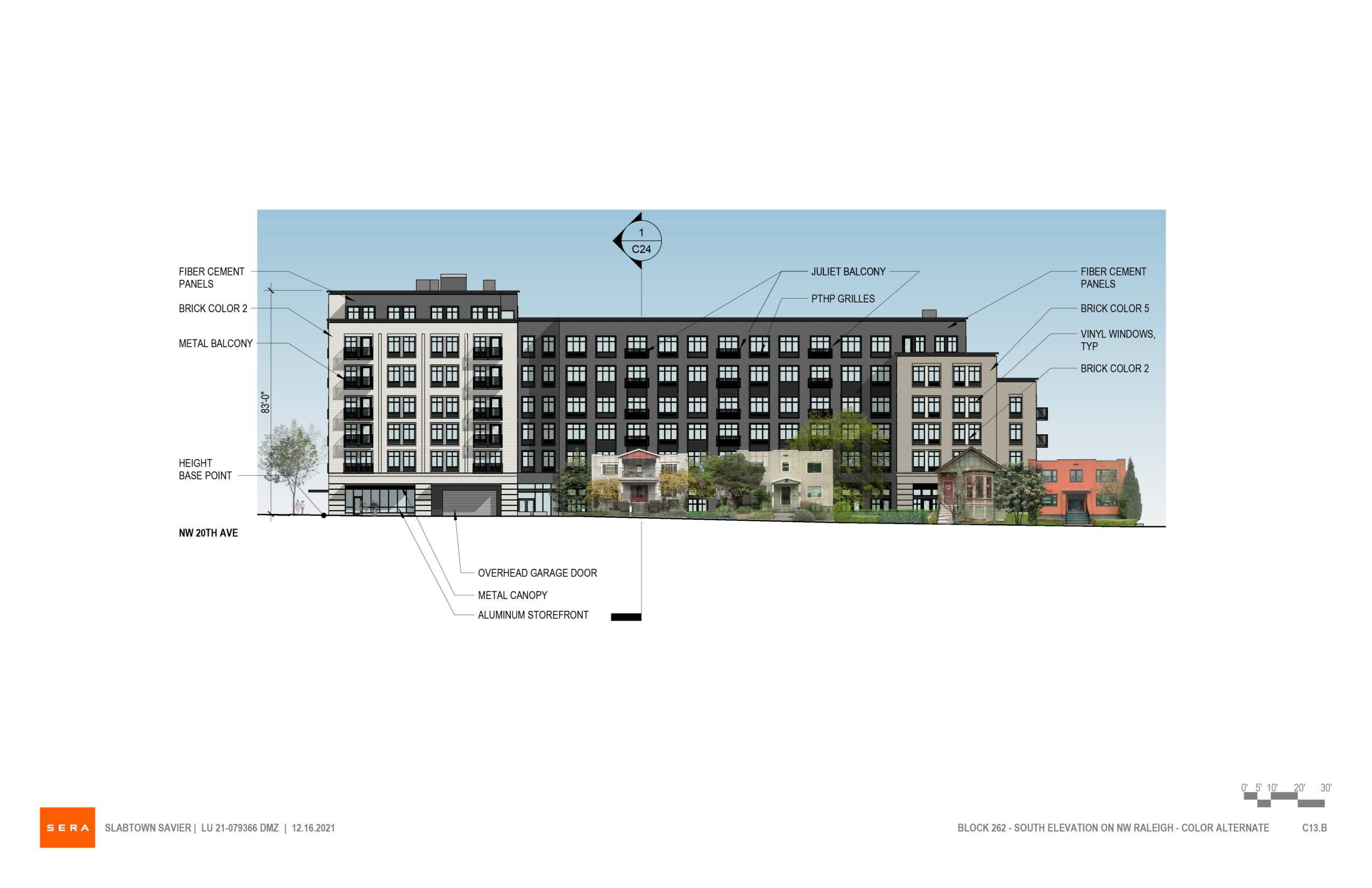
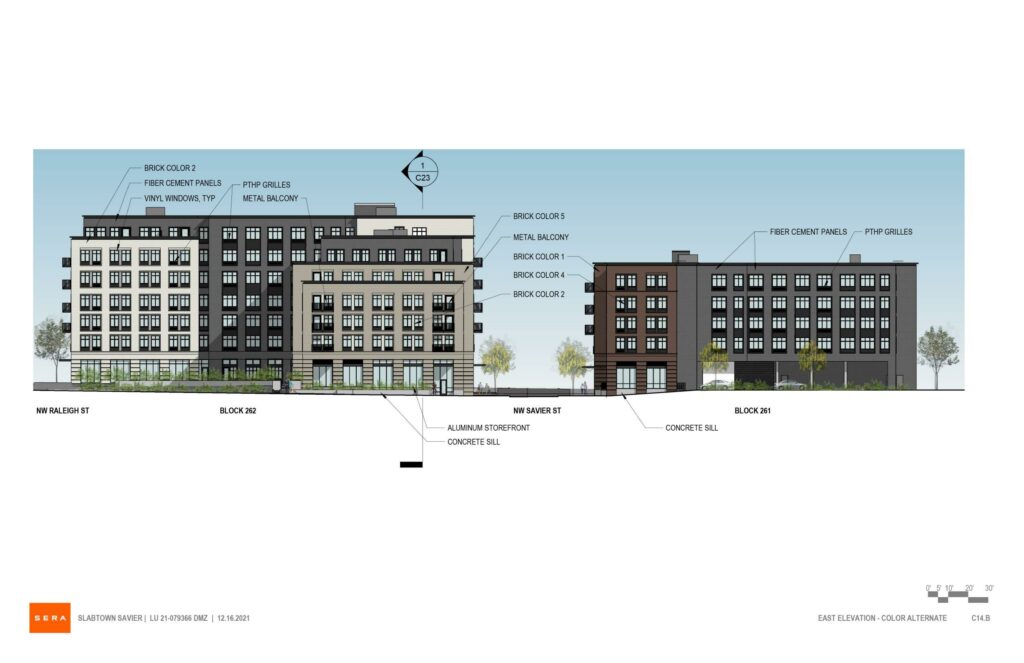
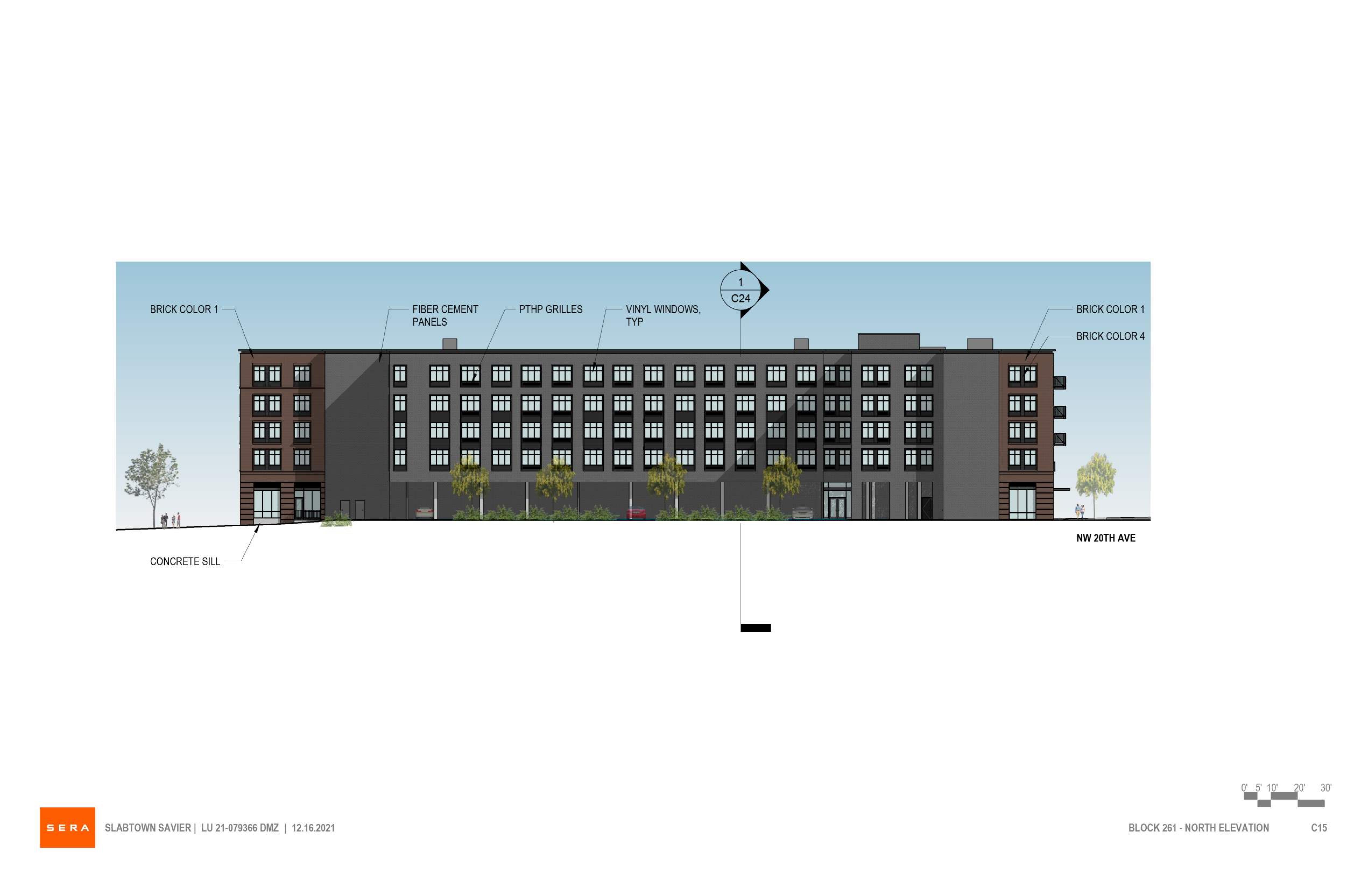
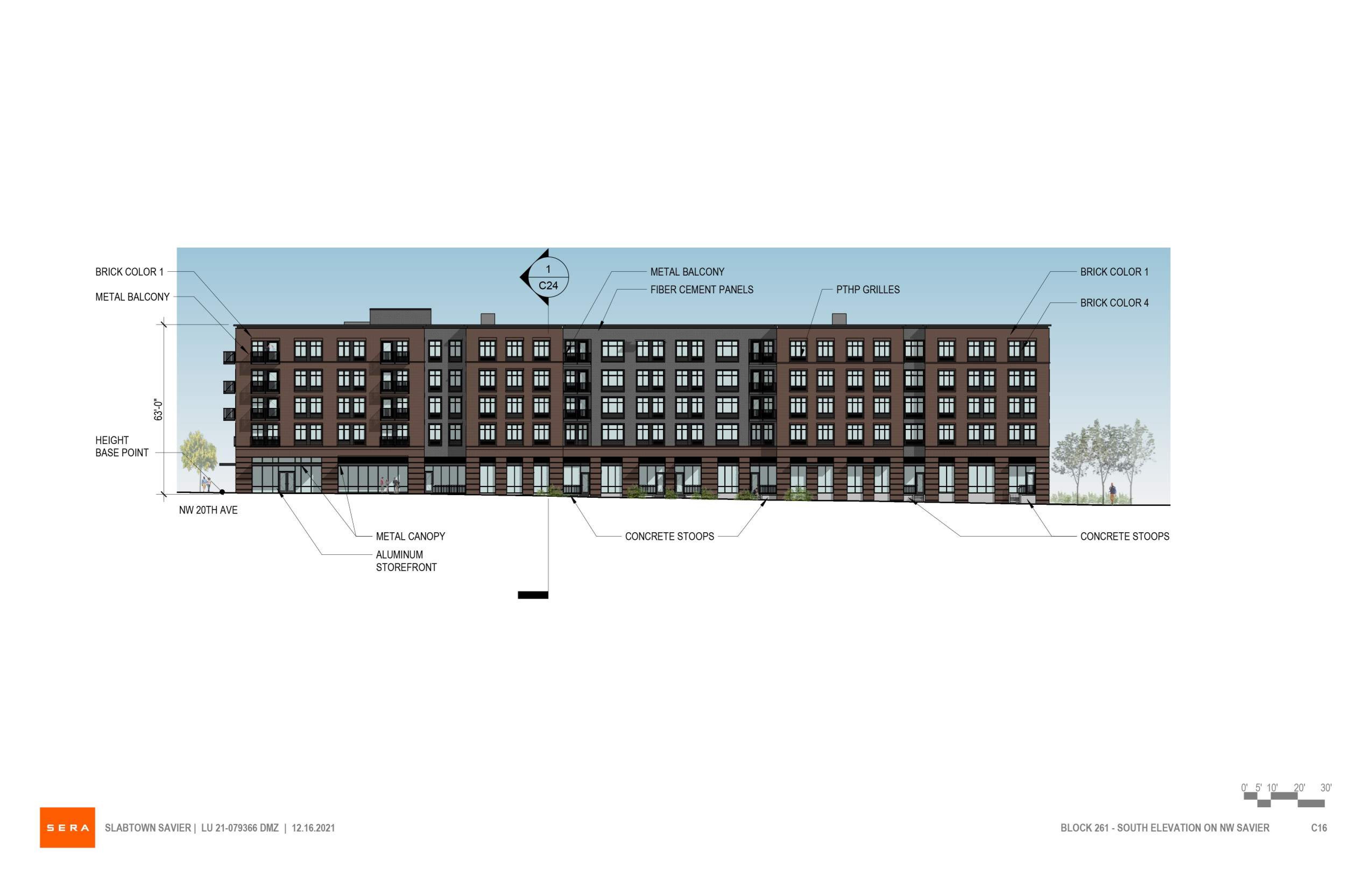
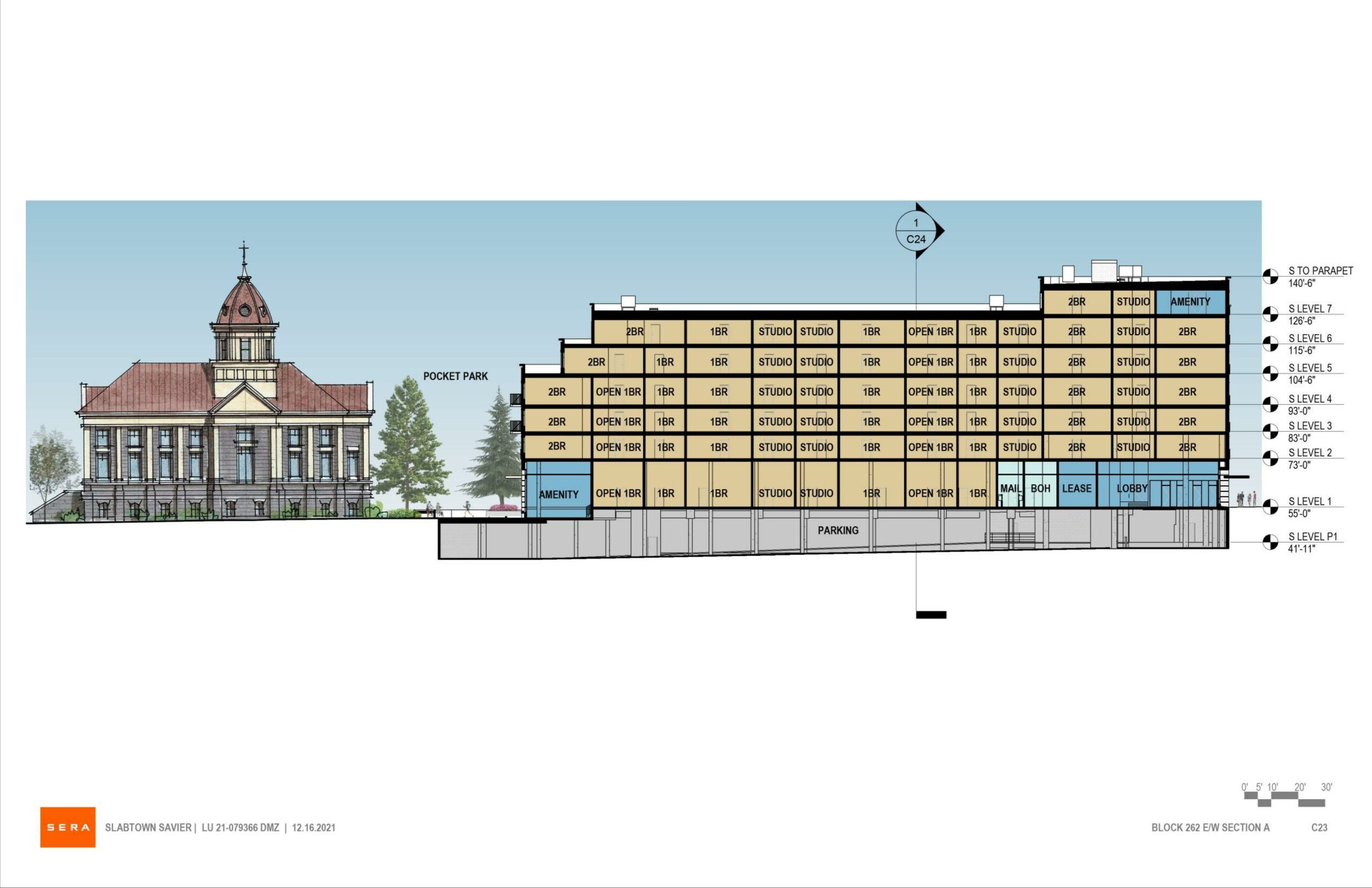
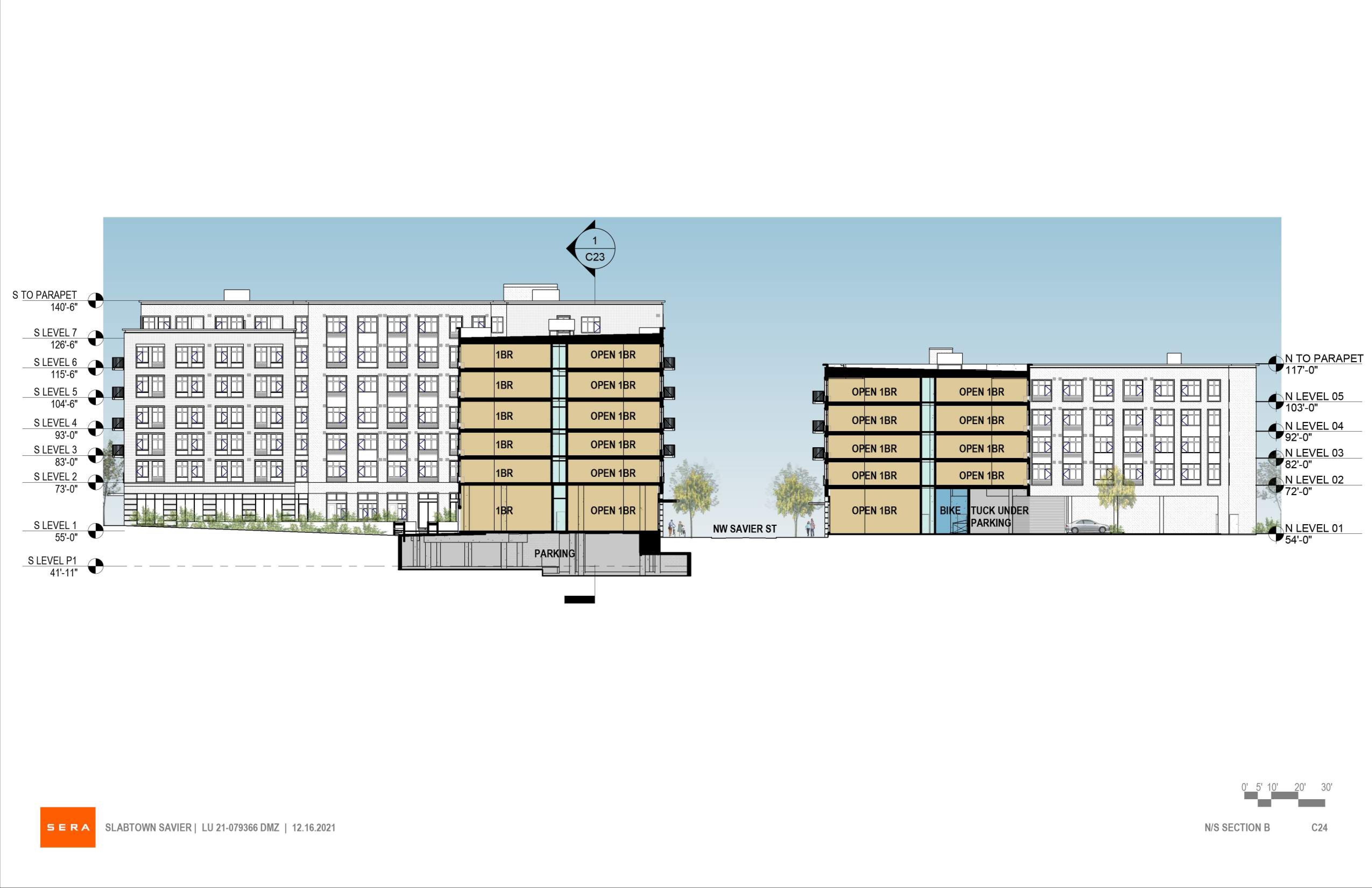
I am so excited for the return to life of this site.
There is a clarification that needs to be made in the Slabtown Savier article. In the intro, that the project comprises “two buildings with 363 market-rate apartments,” but later on write that Block 261 will have 149 units and Block 262, 363 units, which would make a total of 512 units. I’m guessing that in fact Block 262 is planned for 214 units.
Thank you for catching that. Corrected.
Paying 3k to live 20 feet from trucks and motorcycles on highway. Lol
Iain, no need to apologize at all. All of us who read your blog own you a tremendous debt of gratitude. Thanks so much for all of your work on this. good to see it back.
So glad you are back on line. By the way, in case you didn’t know it the Press Building in Goose Hollow on the former Oregonian printing plant site is now under construction.
More accurately, the second phase of the Press Blocks, with the 24 story tower and adjacent mid-rise mixed use building. https://mithun.com/2022/10/20/construction-begins-at-portlands-press-blocks/
Phase 1 of the Pepsi Blocks is under construction. Various preliminary construction permits have been issued for the Alder.9, the Welby, the Timber View in Hazelwood and the condo tower at the former Riverplace Athletic Club on SW Montgomery. Permit applications have been filed or renewed for the Hyatt Place Hotel and Allison Residents in the Pearl District and for the Sandy Pine project. The Design Commission is carrying out an advisory design review for a tower on the last vacant parcel northwest of The Fields park in the Pearl (between Naito and Quimby.) So it appears banks and developers have decided not to flee Portland.
Robert do you know when or if Hyatt place Hotel and Allison Residents, Sandy Pine projects will start construction?
A permit for shoring and tie-backs for the Hyatt and Allison Residences was issued September 22. I was wrong about the Sandy Pine project: I confused it with permits issued for property diagonally southeast across the intersection of Ninth and Sandy permits for a seven-story apartment building with ground floor commercial.
So glad you’re back-missed you and your development updates! Concerning this new development, it is so very similar to all the other projects in the Slabtown/Conway area. The level of sameness of facade delineation and material (brick), height, setback makes a mockery of what should have been a variety of style, rooftops, setbacks for the area. Not to mention adequate open space. I suppose the level of blandness/sameness is all prescribed in the area design guidelines in the guise of “contextuality,” though the area was a blank slate previously. Sooo disappointed in what should have been a vibrant mix, akin to how cities have incrementally grown. Jane Jacobs would be sad.
David, I completely agree with you. I wish City of Portland land use planners, regulators, and developers would take places like the Bar Code district and surrounding area in Oslo, Norway as their inspiration. The scale of the buildings is humane AND the architecture is exciting and varied AND the buildings work together AND the place teems with street-level activity. So much of Portland’s development seems stodgy by comparison.
Not being familiar with Bar Code in Oslo, I looked up photos of its buildings. Yes, there is a vast array of façade treatments that seem to say, “Look at me!”, so I am sure that the Bar Code district draws visitors to gawk, as Hafen City in Hamburg does. But I think the development of the Conway area was driven by the bottom line economically. Had Conway been developed with daring façade treatments like Bar Code, the cost per square foot would have gone up.
DMH, thank you for taking the time to look into the Bar Code development and for inspiring me to research the Hafen City district in Hamburg. I think there is probably a lot of merit to your points about the area being a tourist magnet – it’s near the famous Oslo Opera House, after all, and the outstanding Oslo public library. And I’ve little doubt that our Slabtown developers would like to make a pretty profit, as you point out. But the Bar Code area is not just a place to gawk at; there’s plenty of housing there as well. And in my wanderings around Oslo I was impressed at how creative and pleasing most of the new construction was, including children’s play areas.
Whereas in Portland and elsewhere I’ve visited in the States, there’s a sameness and off-the-shelf look to kids’ climbing equipment and play areas, what struck me in Oslo was that each place I saw (admittedly a small sample size) looked as though it was an original design. This struck me as expressive of a guiding principle that Norwegian cities are worthy of a creative and beautiful built environment.
And there’s more going on in Portland development than just costs, I suspect. According my preliminary research, the median household income in Norway and Portland are, to my surprise, similar. And there are developers in Portland who have done interesting things with not just facades, but also with the shapes of their buildings. The two that come to mind are the Fair-haired Dumbbell at the east end of the Burnside Bridge and the Vanport Building at SW 4th and Montgomery.
I decided to dig deeper via Wikipedia to know more about Bar Code – Oslo. First of all, differing from the Conway blocks, the Oslo land was developed with lots of City government involvement. There was an international competition for the master plan. A number of starchitects designed iconic buildings. Big corporate occupant names are attached to the buildings. The public response runs the gamut. Many love the variety of architecture. Many hate the architectural ensemble because it is chaotic and damaging to the urban environment. Many visitors go there simply to gawk at the buildings.
I will cite my most similar experience in Hafen City, Hamburg which I first visited a decade ago when the ugly Elbphilharmonie concert building was still under construction. I returned to Hafen City last June, walked the expanding and ever-developing district, attended a concert in the still-ugly Elbphilharmonie, and generally gawked at buildings as we architects do. After a while, viewing so many attention-seeking buildings, it felt like having had too many sweet desserts in one sitting. I found myself yearning for Olde Hamburg streets with a sense of urbanity and human scale.
I believe the Conway blocks ended up being owned and developed by a small group of development companies that employed their usual go-to architecture firms. No starchitects. Naturally there are few surprises because their budgets and some prescribed design guidelines set out in the Conway master plan were the drivers. That master plan is a result of intense neighborhood involvement to transform a former parking lot desert into an integral part of NW Portland. After a decade or more, the street trees and landscaping will grow lush and soften the background buildings of the Conway district enough to almost blend with the longer established parts of NW Portland. I’ll bet that is what the neighborhood wanted.
It is interesting to me that in looking at a hundred or so images of the Bar Code area, all of them are aerial views from a distance, not one is from the sidewalk, walking around or sitting next to any of the buildings. The NW neighborhood wanted the street envelope at the Con-way/Slabtown area to work for the folks living there, and to not be given over as forecourts for a bunch of Instagrammable object buildings. No doubt some of the buildings that have been built in Slabtown could have been more adventurous, but the intent was never to build anything like an ‘exciting skyline’, but rather to try to create relaxed, comfortable vibe on the streets for everyone.
David Duncan and David Benson,
I respectfully disagree that Slabtown or anywhere in Portland should look anything like Bar Code in Oslo.
The SERA buildings appear to be highly appropriate to this post-industrial warehouse district of which Portland has a rich history of building types and precedents to reference, relate to and build upon.
DHM refers to Hafen City in Hamburg, whose historic canal warehouse district has some excellent lessons regarding continuity and calmness in building style, material and form. While Hafen also has newer “wild and wacky” intrusions of new starchitecture, like Bar Code, those historic warehouses in Hafen show how the discipline of a sound form basis and material (all brick) results in a beautiful and richly varied districts in which the variety and richness is found at the more detailed level ….not buildings as disjointed and singular objects of each architect’s ego.
With each new building we need to compose whole neighborhood, districts and “the city” comprehensively….not singular building in competition with one another and their neighborhoods.
To echo what others have already said, I’m delighted to see your updates again! I appreciate being able to reference your informative posts in my photos.
Thank you for your time commited to this site!
So happy this site is back!
WOOHOO!! SO glad the site is back! Thank you so much for the hard work you put into this awesome little corner of cyberspace—you are a legend.
Aw yeah! Thank you for coming back online! I’ve been checking weekly for updates. Appreciate your hard work!
Currently under review by the Design Commission (April 2023) are the 12-story hollywoodHUB affordable housing project at the site of the Hollywood Transit Center and Skyview on 7th, a 15-story apartment building across the Metro Center parking structure in the Lloyd District.
Looks like that entry in February was a one time thing, not updated in last six months ??
good
Well, it’s been over a year now since he’s last post, so I’m fairly certain he’s flown the coop, never to return again.
Really wish the posts would continue and appreciate all the work you have done on the site…would happily pay for the content if you resume.
This well-covered progress on the Slabtown Savier development highlights smart urban planning and a strong residential vision for NW Portland. Awesome post.
Pingback: Next Portland is Relaunching, With Your Help – Next Portland